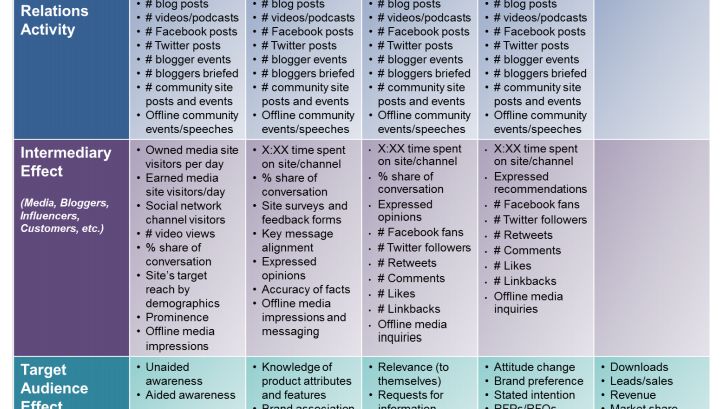
Blog post -
Measuring Digital PR – Part 2: What to measure?
By Adam Cranfield, Digital Marcoms at Mynewsdesk.
In Measuring Digital PR – Part 1: Why Measure? I discussed the purpose of measuring digital communications. In this post I’ll dive a little deeper into what specifically we should be measuring.
Clues you can use
As we looked at in Part 1, good measures provide “actionable insight”. In other words, they give you good clues about what worked, what didn’t, and what to do differently next time.
If, for example, you are running a viral acquisition campaign across social media, you will need to track a number of metrics to be able to answer questions like: Did people want to share the content? Who wanted to share it? Did those who interacted with the content show the desired outcome?
If you gather all the right evidence you may discover, for example, that those who saw the content did indeed show the desired outcome (eg they bought the product), but that the content did not generally inspire people to share it. Or, conversely, you might find that people shared the content a lot, but it failed to produce the desired action of buying the product. In both cases the evidence gives you good ideas about how to improve your approach next time around.
Break it down
Start with objectives, and sub-objectives. Even if the overall objective is to "sell more widgets" or "get more subscribers", the sub-objectives are the steps by which you can get there. So a campaign may be about getting people to share branded content – in which case, measure sharing. Or the strategy may be to gain coverage in influential blogs – in which case you need to measure how many blogs pick up your story and estimate the total number of views.
The reason you need to measure the sub-objectives is so you get the actionable insight: did a campaign succeed/fail because of the level of distribution/sharing achieved, or did it succeed/fail because the content or message was/wasn’t compelling? Or was there another reason?
Haves and AVE-nots
If we move away from "proving success" towards actionable insight, the urge for one killer PR metric quickly subsides. A consensus is forming across the PR industry that AVE (advertising value equivalency) has little or no value to decision makers. As Tim Marklein of Weber Shandwick says in this video, there is no one metric that can or should be used on its own to measure PR success. Instead he stresses the importance of measuring the outcomes that are most relevant to the specific business strategy. The client and agency must work together to agree what these metrics are. Marklein also says that businesses who have the measurement tools, also need the time to properly tie these metrics into their business objectives.
Ogilvy’s Australian CEO Kieran Moore, quoted in PR Week, thinks a new approach to measurement is essential to evolving as an agency, saying: "The aim is to take the role of a business consultancy focused around comms and brand building – rather than be considered a press release factory. AVEs are more about justification than determining actual effectiveness."
Last summer, the Association for Measurement and Evaluation of Communication (AMEC) formally consigned AVEs to PR history and agreed seven principles (the "Barcelona Principles"):
- Goal setting and measurement are important
- Media measurement requires quantity and quality
- AVEs are not the value of public relations
- Social media can and should be measured
- Measuring outcomes is preferred to measuring media results (outputs)
- Organisational results and outcomes should be measured whenever possible
- Transparency and replicability are paramount to sound measurement.
So much to measure, so little time!
As we all know, there is no shortage of stuff to measure online. Econsultancy's Chris Lake made a list of 35 indicators as far back as 2009, and the list has surely only grown since.
But rather than fret about the number of options, perhaps most PR/comms teams would do well to simply focus on making a start with measurement. This was the plee from LEWIS PR's Adam Singer, when he recently blogged "Your PR Team Isn’t Tracking These Metrics …But They Should Be". He highlights three fundamental web metrics to track: referral sources, search traffic and inbound links.
The thorny question of ROI
Many voices demand to know return on investment for digital PR or social media activity. But both PR and truly "social" communications are usually about longer term goals, such as building trust, reputation and, as Katie Payne says, relationships (see Part 1). Increased profit (in the case of a commercial enterprise) is the ultimate reward, but those profits are often harvested a long while after the seeds of trust and reputation have been sown, and relationships nurtured over time.
The complexity of the full picture is shown in the CIPR’s Social Media Measurement Guidance. The model (see diagram 1 below) recognises that the final action/outcome is reached by a series of steps, not just in terms of the "marketing funnel", but also in terms of communication, influencers and end users. In this two-dimensional view, the ultimate objective lies in the lower right cell – labelled "organisation/business result".
The CIPR guidance also provides a sample "filling in" of this chart (see diagram 2 below), in which various metrics can be used to measure performance at each stage. Even if you buy into the framework as a whole, the specific metrics with which you populate the model will surely vary depending on the nature of the business, campaign or objectives.
What metrics do you measure for digital PR and social media? Please tell us below - we'd love to have your input.
In the third part of this series, I'll be looking at whether there are some aspects of digital PR and social media that you simply can't measure.
Photo credit: Blyzz on Flickr (licensed under Creative Commons)

